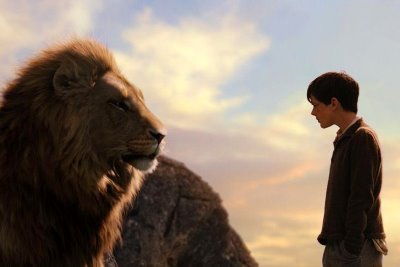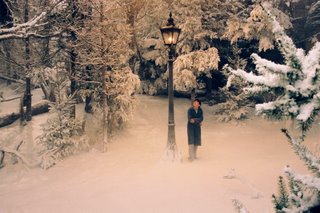 I first read C.S. Lewis' Narnia books in college, after encountering him as a "religious" writer. I was wandering around my high school's library when a title caught my eye: The Screwtape Letters. These words of advice, in what I think used to be Lewis' best-known book, from a senior devil to his junior counterpart on Earth, busy tempting his human to damnation, discomforted me: Screwtape's ideas seemed damnably (sorry) familiar, and led me to question deeply--ah, the irony--my deep questioning of my faith. I felt a bit cornered. It was not a happy read, but in the end Lewis filled me with the kinds of doubts that did the most good when I needed them, at sixteen or so.
I first read C.S. Lewis' Narnia books in college, after encountering him as a "religious" writer. I was wandering around my high school's library when a title caught my eye: The Screwtape Letters. These words of advice, in what I think used to be Lewis' best-known book, from a senior devil to his junior counterpart on Earth, busy tempting his human to damnation, discomforted me: Screwtape's ideas seemed damnably (sorry) familiar, and led me to question deeply--ah, the irony--my deep questioning of my faith. I felt a bit cornered. It was not a happy read, but in the end Lewis filled me with the kinds of doubts that did the most good when I needed them, at sixteen or so. As an English major--also before finding Narnia--I read Lewis' A Preface to Paradise Lost, a humane, sensitive, but also matter-of-fact reading of Milton's poem that righted that blind(-ing) monolith, as in its time Screwtape had upended me. In the Preface as elsewhere, I found in Lewis a critical voice I wanted to emulate, in its subtle conjoining of the personal and the analytical, with a hint of pipesmoke and the small flash and crunch of a firelog spilling open. (If anyone is curious about the Anglophilia that comes so easily to English majors--and not just those happy toilers, but many more who, with varying degrees of pride and embarrassment, turn their faces to Avalon--one need look no further than that ubiquitous, very British tone of straightforward sensitivity encountered everywhere in its literature's old-guard canon, often directed toward the "homely virtues" of the welcoming hearth. Speaking of which, I admit that in college I also discovered The Wind in the Willows, and so powerful was its domestic romanticism that my affection for it withstood even the savage deconstruction of the National Lampoon parody I also read at the time, "The Wimps in the Pillows." What wildly veering turns we do make, even on the short trips.)
 But aside from engendering sentimental affections, Lewis encouraged me to accept the--I want to write, the "martial" elements of faith. As I made my way through college, I felt more clearly my own sense of competition, the urge to win. It bothered me, because I knew much of that just greased the machine's wheels; I was enough of a latent Marxist to recognize the semi-conscious conspiracy to keep me occupied with Major Awards so that I would not notice the real losses incurred by playing the game. But the Narnia books were filled with conflict; and in my confused state I had slurred together "conflict" and "contest," and the desire to win in both had taken on an equivalency they did not warrant. So the more I read Lewis the more I could figure out the distinction, that conflict was not contest, and that settling conflicts was not as clear a job as winning contests. Despite all those swords and conjurations, crownings and thrones, Narnia was still not a place where prizes were awarded, but problems solved. That was, in the end, its greatest attraction for me. I could finally see a life in which the force of my soul (to use Gandhi's phrase) could have the same assertive force as arms--but not (the Mahatma again) as mere "body-force," the exercise of violence out of fear, but as the force of love and reconciliation. Lewis' idealized world remains real because it responds to the martial air with a bowed head and, in low tones, remonstration and forgiveness.
But aside from engendering sentimental affections, Lewis encouraged me to accept the--I want to write, the "martial" elements of faith. As I made my way through college, I felt more clearly my own sense of competition, the urge to win. It bothered me, because I knew much of that just greased the machine's wheels; I was enough of a latent Marxist to recognize the semi-conscious conspiracy to keep me occupied with Major Awards so that I would not notice the real losses incurred by playing the game. But the Narnia books were filled with conflict; and in my confused state I had slurred together "conflict" and "contest," and the desire to win in both had taken on an equivalency they did not warrant. So the more I read Lewis the more I could figure out the distinction, that conflict was not contest, and that settling conflicts was not as clear a job as winning contests. Despite all those swords and conjurations, crownings and thrones, Narnia was still not a place where prizes were awarded, but problems solved. That was, in the end, its greatest attraction for me. I could finally see a life in which the force of my soul (to use Gandhi's phrase) could have the same assertive force as arms--but not (the Mahatma again) as mere "body-force," the exercise of violence out of fear, but as the force of love and reconciliation. Lewis' idealized world remains real because it responds to the martial air with a bowed head and, in low tones, remonstration and forgiveness. So when Aslan takes Edmund aside for a private talk in the recent film version of The Chronicles of Narnia: The Lion, the Witch and the Wardrobe, and they return, and everyone moves on, I was relieved that Disney did not damage the book beyond recognition. I'm not yet sure of my final verdict, but after one viewing I can assert that the movie makes some interesting decisions, and most of them are commendable, if not always as engaging as I'd like them to be. I was worried about the color palette of the movie--the posters and brief scenes I'd allowed myself to glimpse over the past few months made Narnia seem a bit too snappy--but those pastel tents and ultrablue skies have a near-Technicolor brilliance that heightened the movie's urge to raise up the human children to a world they needed to inherit, but still had to earn. (And besides, color is on my mind: I'm getting ready to teach a film class soon, and a good friend suggested I show Singin' in the Rain primarily to wallow in Technicolor. Narnia in this light--so to speak--looks more like Warner Brothers' Sherwood Forest than Peter Jackson's Middle Earth; but such comparisons are for another time.) And Lucy's copious tears, to a jaundiced eye, might seem too frequent, but in the four-sided person the children become she is the conscience, and that can be tearful work. Other elements of the film are visually attractive--the sheer variety of creature has a "Carnival of Animals--Plus" feel that posits Narnia as a Big Place-- and Tilda Swinton brings a proper portion of pre-sexual dread to the White Witch--and I should mention the snowy forest, as cold and richly textured as it should be; those sequences are among the best in the movie.
So when Aslan takes Edmund aside for a private talk in the recent film version of The Chronicles of Narnia: The Lion, the Witch and the Wardrobe, and they return, and everyone moves on, I was relieved that Disney did not damage the book beyond recognition. I'm not yet sure of my final verdict, but after one viewing I can assert that the movie makes some interesting decisions, and most of them are commendable, if not always as engaging as I'd like them to be. I was worried about the color palette of the movie--the posters and brief scenes I'd allowed myself to glimpse over the past few months made Narnia seem a bit too snappy--but those pastel tents and ultrablue skies have a near-Technicolor brilliance that heightened the movie's urge to raise up the human children to a world they needed to inherit, but still had to earn. (And besides, color is on my mind: I'm getting ready to teach a film class soon, and a good friend suggested I show Singin' in the Rain primarily to wallow in Technicolor. Narnia in this light--so to speak--looks more like Warner Brothers' Sherwood Forest than Peter Jackson's Middle Earth; but such comparisons are for another time.) And Lucy's copious tears, to a jaundiced eye, might seem too frequent, but in the four-sided person the children become she is the conscience, and that can be tearful work. Other elements of the film are visually attractive--the sheer variety of creature has a "Carnival of Animals--Plus" feel that posits Narnia as a Big Place-- and Tilda Swinton brings a proper portion of pre-sexual dread to the White Witch--and I should mention the snowy forest, as cold and richly textured as it should be; those sequences are among the best in the movie.  But again, if Narnia matters to me, as a book or a movie, it is because it provides an expression of the urge to accept, not merely the comforts of hearth and the swell of victory, but the problem of conflict divorced from contest, in which one may be crowned, but still has to go home, be the good brother or sister, friend and someday lover, bound by promises that cannot be broken. The trick is to make such promises to those who deserve the bond; there, perhaps, is the rub: It's difficult to spot the White Witch for what she is; all that Turkish Delight, you know. But in Narnia one is given the opportunity to test the promise, to sever the ties that would drag one down, and, hardest of all, to sacrifice oneself to the bond. Sorry, but in Lewis' world a promise is a promise, and while it may be wrestled with as much as submitted to, the promise--as long as it is made in love--is the only thing that matters.
But again, if Narnia matters to me, as a book or a movie, it is because it provides an expression of the urge to accept, not merely the comforts of hearth and the swell of victory, but the problem of conflict divorced from contest, in which one may be crowned, but still has to go home, be the good brother or sister, friend and someday lover, bound by promises that cannot be broken. The trick is to make such promises to those who deserve the bond; there, perhaps, is the rub: It's difficult to spot the White Witch for what she is; all that Turkish Delight, you know. But in Narnia one is given the opportunity to test the promise, to sever the ties that would drag one down, and, hardest of all, to sacrifice oneself to the bond. Sorry, but in Lewis' world a promise is a promise, and while it may be wrestled with as much as submitted to, the promise--as long as it is made in love--is the only thing that matters.
No comments:
Post a Comment